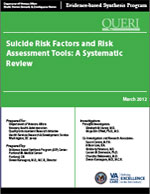
|
Principal Investigators:
Elizabeth M Haney, M.D.;
Maya Elin O'Neil, Ph.D., M.S. Evidence-based Synthesis Program (ESP) Center Portland VA Medical Center Portland, OR; Department of Veterans Affairs; March 2012 |
Download PDF: Complete Report, Executive Summary, Report, Appendices
Suicide is a major public health concern in the United States (US), claiming over 36,000 lives each year and nearly 100 lives each day, and suicide among military and Veteran populations is of particular concern. Veterans returning from the Iraq and Afghanistan conflicts, referred to as Operation Enduring Freedom/Operation Iraqi Freedom (OEF/OIF) Veterans, may be particularly at risk, although the limited available data has shown mixed results. Several aspects of military experience may increase the risk of suicide, including mental health and substance abuse. Many risk factors specific to the OEF/OIF population have yet to be thoroughly evaluated and incorporated into clinical management.
Ideally, suicide risk assessment tools need to account for the relationship among different risk factors and identify risk factors or combinations of risk factors that are particularly associated with suicidal self-directed violence. To be practically useful, such tools will be brief enough to be conducted in a primary care setting and will identify a threshold beyond which preventive action should be taken. Risk assessment tools should be able to discriminate those at high-and low-risk for suicidal self-directed violence. Likewise, studies of emerging risk factors need to evaluate the contribution of a new potential predictor of suicide and self-directed violence in the context of known risk factors in order to weigh the contribution of the new risk factor against those that are currently known.
The objective of this report is to review recent evidence about risk factors and risk assessment tools within Veteran and military populations to provide evidence for clinical practice guideline development specific to these populations.
The key questions addressed in this report were: